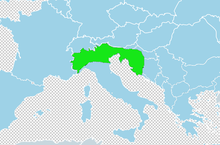Salmo marmoratus
| Salmo marmoratus | |
|---|---|

| |
| Scientific classification | |
| Domain: | Eukaryota |
| Kingdom: | Animalia |
| Phylum: | Chordata |
| Class: | Actinopterygii |
| Order: | Salmoniformes |
| Family: | Salmonidae |
| Genus: | Salmo |
| Species: | S. marmoratus
|
| Binomial name | |
| Salmo marmoratus G. Cuvier, 1829
| |

| |
Salmo marmoratus, the marble trout, is a species of
Distribution
In Italy, marble trout inhabits left tributaries of the upper northwestern reaches of the
Appearance, biology, and ecology

The marble trout has a long, cylindrical body, slightly compressed laterally, with a large head (22–25% of the body length), which is why it is also known as glavatica (glava = head) in Bosnian. The most obvious characteristic of the marble trout is its marble pattern. The intensity of colour varies considerably upon the surroundings. Some marble trout have red spots that merge with the rest of the pigment, always only along the lateral line.[6]
Its typical size is 30–70 cm. The largest specimen in Slovenia was a 117-cm, 24-kg female (found dead), become sexually mature at the age 3+ years (males) and 4+ years (females), and they spawn during November and December.
The marble trout is
Its natural
All eight remaining genetically pure marble trout populations were found in remote streams of the River Soča basin.[10] From these populations the Tolmin Angler's Society launched a reintroduction programme.[11]
Marmorated trout
Adding to the confusion of salmonid taxonomy, other trout have marble patterns beside S. marmoratus. One is trout from the river Otra, Norway. A certain percentage of brown trout (Salmo trutta) from that river have a marble pattern. In all other aspects, these trout are identical to the nonmarble brown trout from the same river. This is an example of intrapopulational polymorphism.[12][13]
References
- . Retrieved 14 November 2021.
- ^ "Fish Database - Save the Blue Heart of Europe". balkanrivers.net. Retrieved 1 July 2019.
- ^ "Marble trout (Salmo marmoratus)". Balkan Trout Restoration Group. Retrieved 2009-03-10.
- ^ S. MUHAMEDAGIĆ; H. M. GJOEN; M. VEGRA (2008). "Salmonids of the Neretva river basin - p" (PDF). EIFAC FAO Fisheries and Aqauculture Report No. 871. European Inland Fisheries Advisory Commission (EIFAC): 224–233. Retrieved 6 January 2014.
- PMID 19284692.
- ^ a b Povž M; Jesenšek D; Berrebi P; Crivelli AJ (1996). The Marble Trout Salmo trutta marmoratus, Cuvier 1817 In the Soca River basin, Slovenia (PDF).
- ^ Pintar L (1991). "Najtežja soška postrv je končala pod peskom". Ribič. 50 (1–2): 16.
- ^ "Soca (19) – Ribiška družina Tolmin".
- ISBN 953-99019-3-6.
- S2CID 23810662.
- ^ Fish farming
- ^ Skaala O; Solberg G (1997). "Biochemical genetic variability and the taxonomic position of the marmorated trout in River Otra, Norway". Nord. J. Freshw. Res.
- ^ Crivelli, A.J. (2006). "Salmo marmoratus". IUCN Red List of Threatened Species. 2006. Retrieved 2020-05-28.

